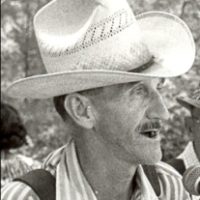
Stanley Hicks
Stanley Hicks was born in 1911 in Watauga County, and raised on Spice Creek along with his eight siblings. He and his cousin Ray Hicks, also a famed storyteller, shared the same great-grandparents. Life for the Hicks family was hard; there were few jobs in the mountains, and families struggled to get enough food. Growing up, Hicks took what jobs were available. During the Depression, he worked for the Works Progress Administration for 75 cents a day. If the road crews were hiring, he did that kind of work, and if they needed someone to haul water, he volunteered. Like many others in the Blue Ridge region, he occasionally had to travel away from home to earn a living and support his family. He worked for an orchard in upstate New York, for a manufacturing plant in Virginia, and for a chicken farmer in the Piedmont.
From his family, Stanley Hicks was taught to become independent and self-sufficient. Like his grandfather Sam and father Roby, he learned to make finely crafted banjos and dulcimers. He made his first banjo when he was 15 years old, using a cat hide for its head and wood from the walnut and cherry trees that grew on the ridges near his farm.
As a young man, he liked to participate in corn shuckings and square dances, which were held wherever there was room. If there wasn’t room in a barn to dance, the dancers would take turns, or the group might hold its dance outside. Many of the young men played banjo and fiddle, but no one ever played dulcimer at a square dance, Hicks remembered. In addition to playing for square dances, he was renowned for his flatfoot jumping-jack dance, which he learned at Beech Mountain play parties as a child.
Hicks cut his finger off at the joint while making dulcimer finger boards, and this disability forced him to abandon the clawhammer style he played on the banjo and develop his own individualized approach. He loved to perform and tell stories as he played. He was an exemplar of the creative traditions that have long flourished in the close-knit families of Appalachia.


